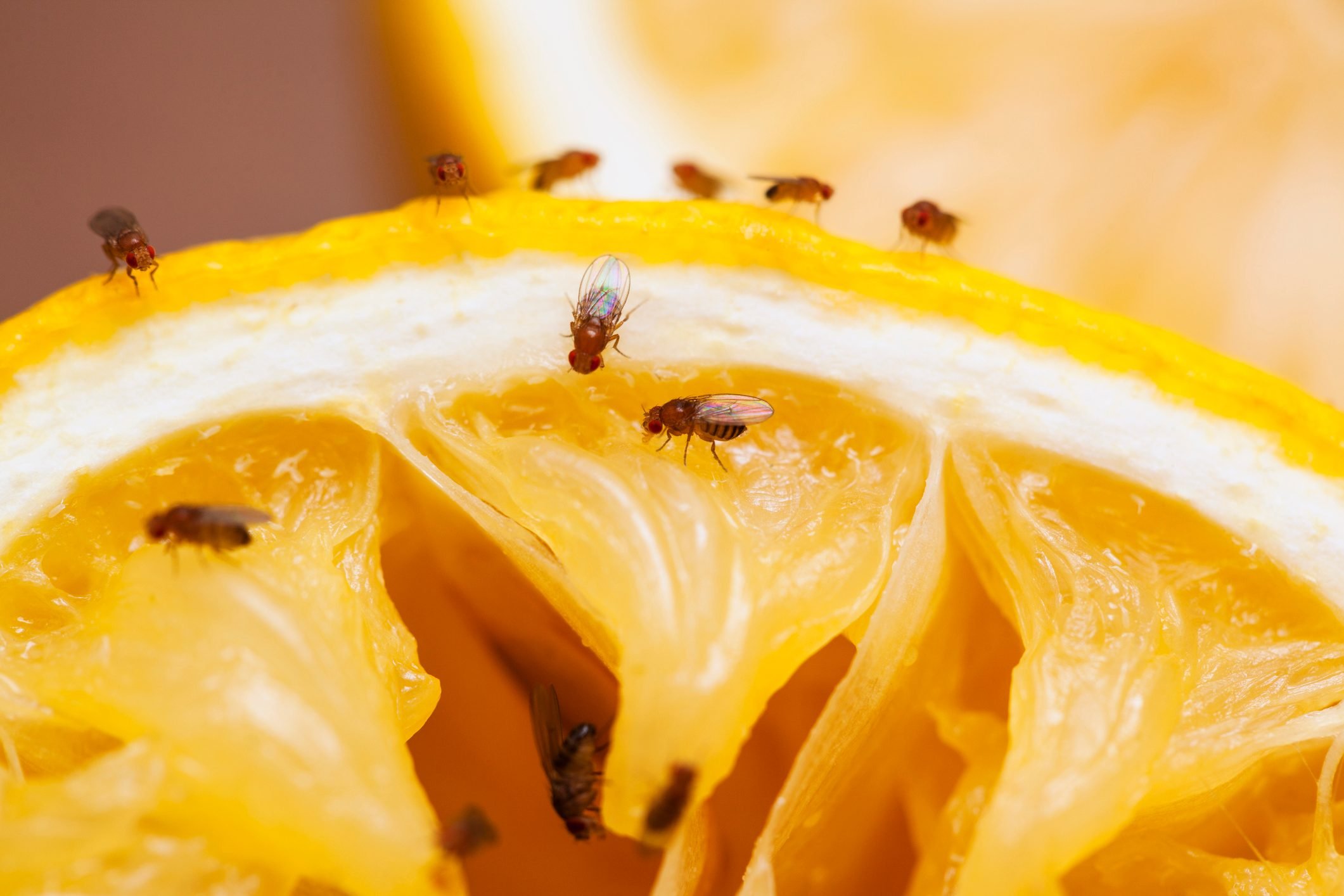
From mid spring to early autumn, flying pests become the bane of our lives, both outdoors and indoors. Whether it’s fending off mosquitos or managing ants, we’re all seeking solutions. However, fruit flies can out-annoy them all. If these miniature nuisances are hovering around your drain or fruit bowl, fret not. There are quick, easy home remedies that can address the fruit fly problem before resorting to harsh chemicals.
This detailed guide by pest control specialists will arm you with strategies to understand what lures fruit flies, locate their source, uphold cleanliness, deploy practical DIY measures and learn how to get rid of fruit fly infestation as a whole.
What attracts fruit flies?
Fruit flies, as their name suggests, are primarily drawn to ripened or decaying fruits and vegetables. This is due to the fermentation process that these food items undergo, releasing a strong odour that attracts these flying pests.
However, their interest isn’t just limited to fruit. Fruit flies are also attracted to rubbish bins, unwashed dishes, and even slime that builds up within drains. In essence, any organic material that is decomposing can become a magnet for these pests.
While it’s true that fruit flies are more common in warmer months, they can appear at any time of the year, especially if they find their favourite food source. It’s thus essential to keep food and waste products properly stored and disposed of to prevent attracting them.
Keep common areas clean
Uncovering the root of the infestation is how to get rid of fruit fly infestation. Fruit flies are known to reproduce and lay their eggs in humid, fermenting materials, such as overripe fruits, drains, garbage disposals, mops, and cleaning rags. With each female fruit fly capable of laying around 500 eggs, it’s easy to see how a large-scale infestation can develop rapidly.
It’s important to carry out a thorough inspection of your home. Examine all potential breeding spots, such as the underside of your bin, the drains, fruit baskets, and beneath appliances.
Upon identifying the source, act immediately by discarding it. Any cleanable items, like containers or surfaces, should be thoroughly scrubbed with a bleach-based solution to eliminate any lingering eggs or larvae.
Find the source of the infestation
All pest exterminators will advise you that maintaining a high standard of cleanliness in your home can go a long way towards preventing fruit fly infestations. Fruit flies are opportunistic and will take advantage of any favourable conditions to breed and multiply.
Ensure your kitchen, dining, and living areas are free of food crumbs or spills. Regularly clean surfaces, floors, and appliances where food particles can accumulate. Make sure all food containers are sealed tightly and ripe fruits and vegetables are refrigerated or at least covered.
Similarly, maintain your outdoor spaces. Ensure compost heaps are covered and fallen fruits or vegetables are picked up promptly.
Remember, prevention is better than cure. By keeping your common areas clean, you’re denying fruit flies the conditions they need to thrive.
Use rotten fruit against fruit flies
The aroma of decomposing fruits can serve as an excellent lure for fruit flies, drawing them into a mixture from which escape is tricky due to the funnel-like structure of this trap. Here’s how to construct it:
- Add a small quantity of vinegar and a piece of extremely ripe fruit into a jar.
- Fashion a paper into a cone shape and insert it into the jar, ensuring the narrow opening points downwards so they cannot escape after entering. You can recycle or compost the homemade funnel once it’s served its purpose.
Alternatively, you can cut the top off a plastic bottle and use this as the narrow entrance for the flies to pass through. Fill the bottom with vinegar and ripe fruit to ensnare and drown them.
Make a DIY trap
Have a bit of red wine left over that you don’t foresee being consumed? Put it to good use by creating a functional fruit fly trap. Here’s the procedure:
- Pour a modest amount of red wine and dish soap into a disposable container, then give it a good mix.
- Stretch a piece of cling film over the top of the container.
- Create small apertures in the cling film. Ensure the holes are large enough for the fruit flies to pass through.
The aromatic allure of wine will attract the fruit flies, and the mixture of wine and dish soap will hinder their ability to fly, ultimately causing them to drown. Repeat this process until there’s no sign of any remaining fruit flies.
Use vinegar solution
Good old vinegar is one more answer to the question of how to get rid of fruit fly infestation. The scent of fermenting produce acts as an excellent bait for fruit flies, and as another strategic setup, you can create a trap they find impossible to escape from. Here’s how you can create your own:
- Fill a small basin halfway with vinegar;
- Add a few drops of dish soap to this mixture. The soap breaks the surface tension of the vinegar, ensuring that any fruit fly attracted to the scent of the fermenting fruit will sink and drown rather than being able to land and then fly away.
There’s no need to cover the bowl in this type of trap. The soap-altered surface tension of the vinegar will ensure the flies can’t escape once they’ve landed. Simply place the bowl in an area where you’ve noticed fruit fly activity and let the trap do its work.
Take out the garbage regularly
All pest exterminators will tell you garbage is a significant attraction for fruit flies. The decaying organic matter in your bin provides them with the perfect breeding ground. Make it a habit to empty your bin daily, especially in the warmer months when fruit flies are more active.
Additionally, it’s important to clean your bins frequently. Even after the garbage is taken out, traces of organic material can remain, attracting more fruit flies. Use a disinfectant to remove all remnants and leave the bin clean and dry.
Repel fruit flies with herbs
Nature has provided us with a plethora of herbs renowned for their capabilities to deter fruit flies. The likes of basil, lemongrass, peppermint, and lavender are well known for their insect-repelling characteristics.
These plants can be placed strategically around your home, particularly in spots frequented by fruit flies, such as the kitchen, dining area, or near waste bins.
Alternatively, you can make a DIY natural repellent spray. Mix water with a few drops of essential oils from any of the mentioned plants. Spray this mixture around your home, focusing on areas where fruit flies are most prevalent.
Hire pest control experts
At times, in spite of your most diligent efforts, the infestation could potentially spiral beyond control. It’s during such instances that seeking professional help becomes essential. Pest control experts, with their specialised training and tools, are well-equipped to completely obliterate fruit fly infestations. Furthermore, they can provide valuable tips on how to avert future invasions.
Although hiring pest control services might appear to be an added cost, it can actually save you considerable time and stress in the long run. They have the capability to efficiently stamp out the issue and guarantee that your home remains devoid of pests.
Conclusion
Safeguarding your home against fruit fly invasions requires a blend of preemptive actions and responsive approaches. Maintaining cleanliness routinely, disposing of garbage promptly, and implementing DIY traps can greatly minimise the chance of an infestation.
But should the situation intensify, don’t be reluctant to contact the pest exterminators. While fruit flies may appear harmless, they transmit diseases and can jeopardise your wellbeing and health in the long run. Adhere to the procedures specified in this guide, and you’ll be well on your way to a fruit-fly-free dwelling.




